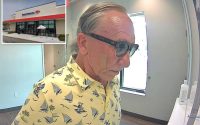Why did cop wait hours to warn community Huu Can Tran was on the loose?
California police officials are being criticized for waiting more than five hours to alert the public that the Monterey Park mass shooter was on the loose, it was revealed, as cops still continue to search for a motive behind the bloodshed.
Huu Can Tran, 72, opened fire at the Star Ballroom Dance Studio around 10:20 p.m. on Saturday night, killing 11 members of the LA area Asian-American enclave’s Chinese community.
Twenty minutes later, Tran went to a nearby rival dance studio, where patrons heroically disarmed him of a MAC-10 assault weapon, police said.
Danger the obvious danger to the public, police made no announcement about the suspect’s location until 3:30 a.m., when LA County Sheriff’s Capt. Andrew Meyer told reporters the “suspect fled the scene and remains outstanding,” the Times reported.
The community was not placed under lockdown and at a news conference several hours later LA County Sheriff Robert Luna assured the public they were not in danger.

“When we started putting out public information, the priority was to get this person into custody, so we were very strategic in the way we were putting out information,” Luna reportedly said on Monday, defending the strategy.
“Ultimately, it worked.”
By 11:20 a.m. Saturday, cops had finally issued a bulletin with security camera pictures of Tran, warning he was considered “armed and dangerous,” according to the report.

Horace Frank, a former assistant chief at the Los Angeles Police Department, told the LA Times that the department’s approach seemed to fly in the face of logic.
“It is a public safety issue,” he said.
“The only time you don’t do that is when you can articulate specific reasons otherwise. You always err on the side of keeping the public informed,” the former LAPD tactical operations expert continued.

“If there is a reason for delay, I cannot think of one.”
“It is not usual to wait that long if they have a known suspect. However, there is always the possibility they have a good reason,” he said.

“These are rapidly unfolding events, even after the shooting stops. Dealing with multiple victims, crime scene processing, large number of witnesses, an active manhunt and all the other factors and dynamics at play make these events highly complex.”
Retired LA County Sheriff Department chief of special operations said cops might have been strategically withholding information.
“During a manhunt for dangerous suspects, law enforcement must follow up on leads and use measures to determine a suspect’s location,” he reportedly said.

“Sometimes, it’s not prudent to reveal the source of leads or how you intend to find the suspect, particularly when it involves intel or technology.”
His assertion was echoed by Aili Malm, a professor of criminology and criminal justice at Cal State Long Beach.
“It’s not usual to wait hours to release information about such a critical incident when they might want to increase public safety or use the public’s help in solving the crime,” Malm told the outlet.
Monterey Park Police Chief Scott Wiese reportedly said his officers were canvassing the community looking for the gunman shortly after the shooting.

“We began to associate the suspect there with what we thought was the description of the suspect here,” Wiese told the paper. “The weapon description was similar, and that’s when we started to put it all together.”
“It was very fragmented,” he said. “We had two crime scenes, and trying to get that info and make sure it was precise and that it was information the public could actually use takes a little bit of time.
“By the time we could get the information out, we did,” he added.
Luna had reportedly said his department was assessing the investigation to see “what worked and specifically what didn’t work.
The victims — who were in their 50s, 60s and 70s — were out dancing to celebrate the Lunar New Year.
The shooter, from Hemet, Calif., died the next day from a self-inflicted gunshot wound as cops in the seaside community of Terrance closed in on him, some 30 miles from the San Gabriel Valley mass shooting scene.
It was still not exactly clear why the “isolated gun enthusiast,” who once frequented the local dance venue, carried out his ghastly attack, according to The Los Angeles Times.
Initial reports had suggested he was jealous that his ex-wife had been invited to the dance party, and he harbored grudges against the club’s dance instructors — although he appeared to have no personal link to any of the victims, investigators said.


